Transcriptomic analysis of Perilla frutescens seed to insight into the biosynthesis and metabolic of unsaturated fatty acids
- PMID: 29562889
- PMCID: PMC5863459
- DOI: 10.1186/s12864-018-4595-z
Transcriptomic analysis of Perilla frutescens seed to insight into the biosynthesis and metabolic of unsaturated fatty acids
Abstract
Background: Perilla frutescens is well known for its high α-linolenic acid (ALA) accumulation in seeds and medicinal values as well as a source of edible and general-purpose oils. However, the regulatory mechanisms of the biosynthesis of fatty acid in its seeds remain poorly understood due to the lacking of sequenced genome. For better understanding the regulation of lipid metabolism and further increase its oil content or modify oil composition, time-course transcriptome and lipid composition analyses were performed.
Results: Analysis of fatty acid content and composition showed that the α-linolenic acid and oleic acid accumulated rapidly from 5 DAF to 15 DAF and then kept relatively stable. However, the amount of palmitic acid and linoleic acid decreased quickly from 5 DAF to 15DAF. No significant variation of stearic acid content was observed from 5 DAF to 25DAF. Our transcriptome data analyses revealed that 110,176 unigenes were generated from six seed libraries at 5, 10, 20 DAF. Of these, 53 (31 up, 22 down) and 653 (259 up, 394 down) genes showed temporal and differentially expression during the seed development in 5 DAF vs 10 DAF, 20 vs 10 DAF, respectively. The differentially expressed genes were annotated and found to be involved in distinct functional categories and metabolic pathways. Deep mining of transcriptome data led to the identification of key genes involved in fatty acid and triacylglycerol biosynthesis and metabolism. Thirty seven members of transcription factor family AP2, B3 and NFYB putatively involved in oil synthesis and deposition were differentially expressed during seed development. The results of qRT-PCR for selected genes showed a strong positive correlation with the expression abundance measured in RNA-seq analysis.
Conclusions: The present study provides valuable genomic resources for characterizing Perilla seed gene expression at the transcriptional level and will extend our understanding of the complex molecular and cellular events of oil biosynthesis and accumulation in oilseed crops.
Keywords: Fatty acid biosynthesis; Gene expression profiling; Perilla frutescens; RNA-seq; Seed development.
Conflict of interest statement
Ethics approval and consent to participate
Not applicable.
Consent for publication
Not applicable.
Competing interests
The authors declare that they have no competing interests.
Publisher’s Note
Springer Nature remains neutral with regard to jurisdictional claims in published maps and institutional affiliations.
Figures
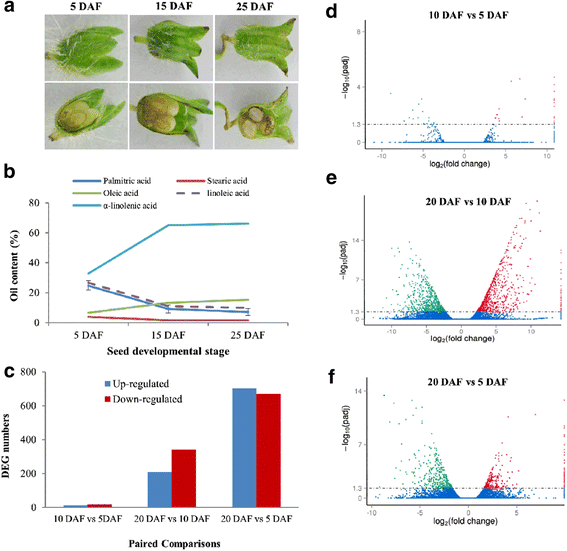
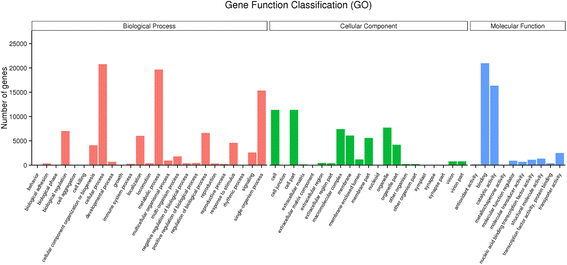
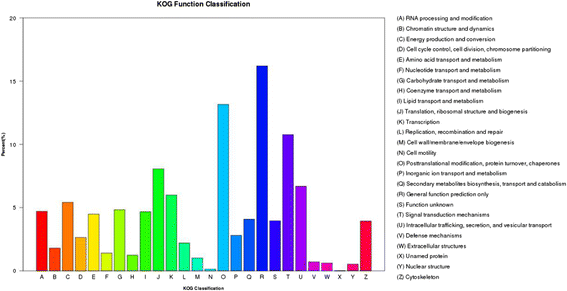
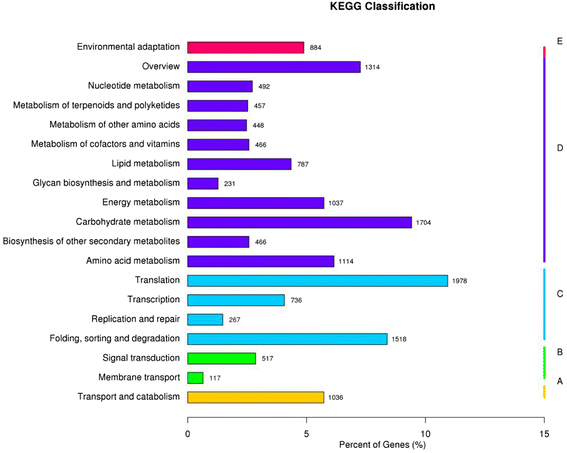
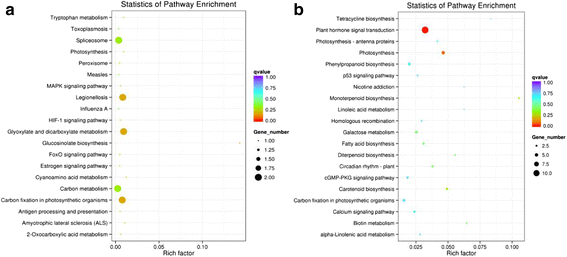
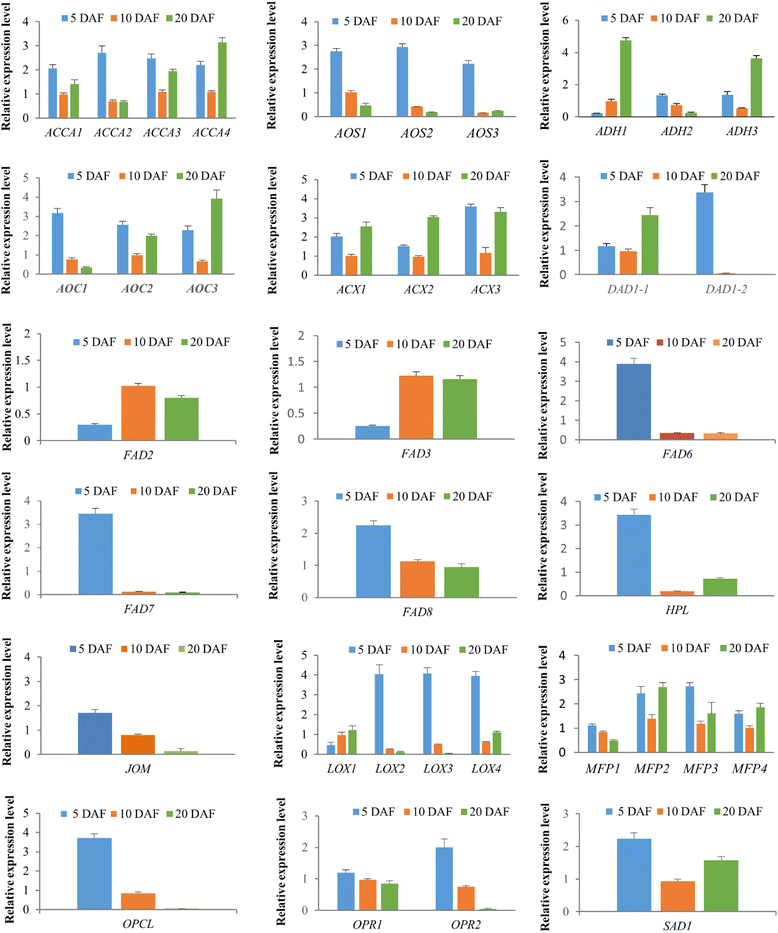
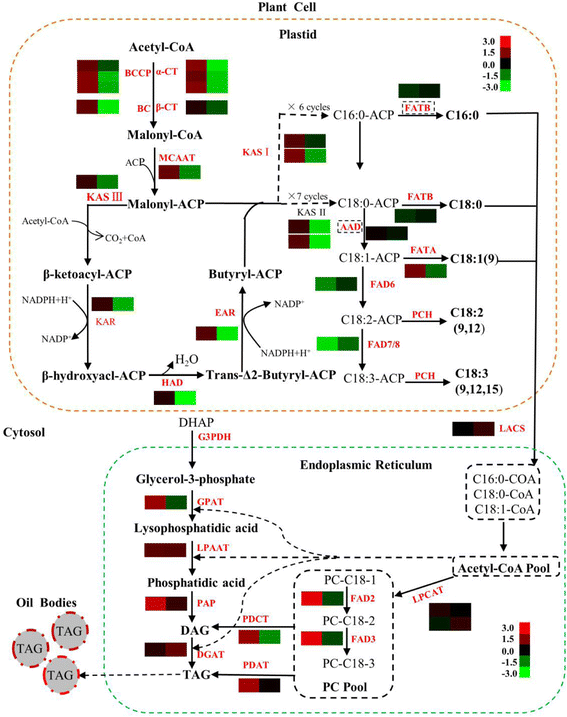

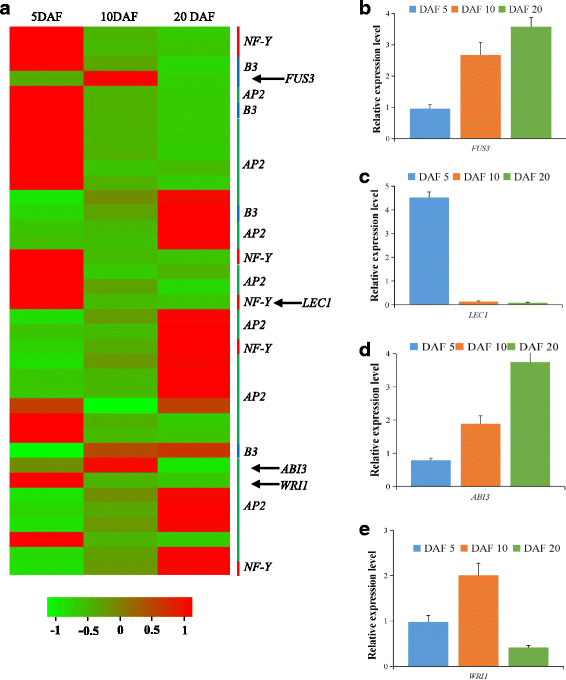
Similar articles
-
Transcriptome analysis and identification of genes associated with ω-3 fatty acid biosynthesis in Perilla frutescens (L.) var. frutescens.BMC Genomics. 2016 Jun 24;17:474. doi: 10.1186/s12864-016-2805-0. BMC Genomics. 2016. PMID: 27342315 Free PMC article.
-
RNA Sequencing and Coexpression Analysis Reveal Key Genes Involved in α-Linolenic Acid Biosynthesis in Perilla frutescens Seed.Int J Mol Sci. 2017 Nov 16;18(11):2433. doi: 10.3390/ijms18112433. Int J Mol Sci. 2017. PMID: 29144390 Free PMC article.
-
Genome-wide comprehensive characterization and transcriptomic analysis of AP2/ERF gene family revealed its role in seed oil and ALA formation in perilla (Perilla frutescens).Gene. 2023 Dec 30;889:147808. doi: 10.1016/j.gene.2023.147808. Epub 2023 Sep 16. Gene. 2023. PMID: 37722611
-
Genetic possibilities for altering sunflower oil quality to obtain novel oils.Can J Physiol Pharmacol. 2008 Apr;86(4):215-21. doi: 10.1139/Y08-008. Can J Physiol Pharmacol. 2008. PMID: 18418432 Review.
-
Perilla Seed Oil and Protein: Composition, Health Benefits, and Potential Applications in Functional Foods.Molecules. 2024 Nov 7;29(22):5258. doi: 10.3390/molecules29225258. Molecules. 2024. PMID: 39598647 Free PMC article. Review.
Cited by
-
Genome-wide characterization of PEBP gene family in Perilla frutescens and PfFT1 promotes flowering time in Arabidopsis thaliana.Front Plant Sci. 2022 Nov 18;13:1026696. doi: 10.3389/fpls.2022.1026696. eCollection 2022. Front Plant Sci. 2022. PMID: 36466292 Free PMC article.
-
Transcriptome Analysis of Genes Involved in Fatty Acid and Lipid Biosynthesis in Developing Walnut (Juglans regia L.) Seed Kernels from Qinghai Plateau.Plants (Basel). 2022 Nov 23;11(23):3207. doi: 10.3390/plants11233207. Plants (Basel). 2022. PMID: 36501246 Free PMC article.
-
A comprehensive review on nutritional, nutraceutical, and industrial perspectives of perilla (Perilla frutscens L.) seeds - An orphan oilseed crop.Heliyon. 2024 Jun 18;10(12):e33281. doi: 10.1016/j.heliyon.2024.e33281. eCollection 2024 Jun 30. Heliyon. 2024. PMID: 39022021 Free PMC article. Review.
-
Comprehensive Review of Perilla frutescens: Chemical Composition, Pharmacological Mechanisms, and Industrial Applications in Food and Health Products.Foods. 2025 Apr 3;14(7):1252. doi: 10.3390/foods14071252. Foods. 2025. PMID: 40238536 Free PMC article. Review.
-
Quality changes in perilla seed powder related to storage duration and temperature.J Food Sci Technol. 2020 Jan;57(1):263-273. doi: 10.1007/s13197-019-04056-2. Epub 2019 Aug 26. J Food Sci Technol. 2020. PMID: 31975729 Free PMC article.
References
-
- Park YJ, Dixit A, Ma KH, Lee JK, Lee MH, Chung CS, Nitta M, Okuno K, Kim TS, Cho EG. Evaluation of genetic diversity and relationships within an on-farm collection of Perilla frutescens (L.) Britt. Using microsatellite markers. Genet Resour Crop Evol. 2008;55(4):523–535. doi: 10.1007/s10722-007-9258-x. - DOI
-
- Shin HS, Kim SW. Lipid composition of perilla seed. J Am Oil Chem Soc. 1994;71(6):619–622. doi: 10.1007/BF02540589. - DOI
-
- Ciftci ON, Przybylski R, Rudzińska M. Lipid components of flax, perilla, and chia seeds. Eur J Lipid Sci Technol. 2012;114(7):794–800. doi: 10.1002/ejlt.201100207. - DOI
Publication types
MeSH terms
Substances
Grants and funding
LinkOut - more resources
Full Text Sources
Other Literature Sources
Research Materials
Miscellaneous

